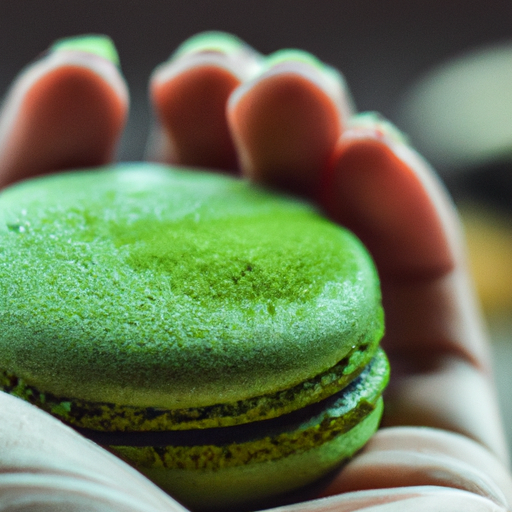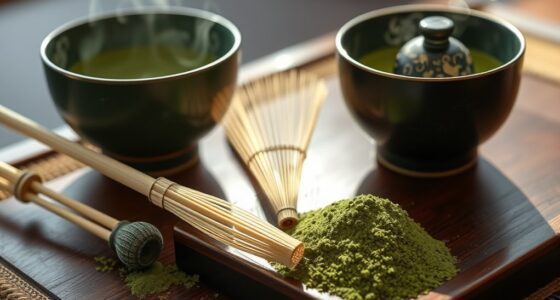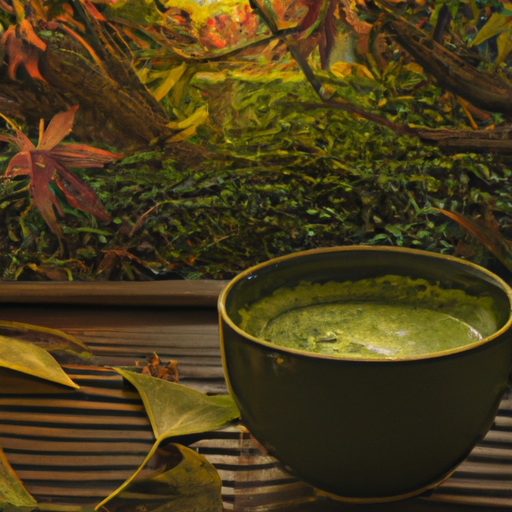Are you aware that for centuries, traditional Japanese tea ceremonies have incorporated the use of ceremonial matcha? This brightly colored green tea powder has risen in popularity lately, thanks to its wide array of health advantages and distinctive taste. As someone who passionately enjoys matcha, I’m eager to tell you everything there is to know about ceremonial matcha, including its background, and how it stands apart from different varieties of matcha.
Ceremonial matcha is the highest grade of matcha available and is made from the youngest tea leaves, which are hand-picked and then stone-ground into a fine powder. The quality of ceremonial matcha is determined by the color, texture, and taste of the powder. It is known for its vibrant green color and smooth, creamy texture, as well as its sweet and earthy flavor.
But what sets ceremonial matcha apart from other grades of matcha? Keep reading to find out.
Key Takeaways
- Ceremonial Matcha is a high-quality tea made from hand-picked young tea leaves that are stone-ground into a fine powder.
- It has a unique sweet and earthy flavor with a smooth, creamy texture and is best consumed in a matcha latte.
- The Uji region in Japan produces over 75% of the world’s matcha and is known for producing the highest quality ceremonial matcha.
- Proper storage is crucial for maintaining the quality and freshness of ceremonial matcha, which is highly sensitive to air, light, and humidity.
What Is Ceremonial Matcha?
Ceremonial matcha is a finely ground powder made from shade-grown green tea leaves. It is a traditional staple in Japanese tea ceremonies, with cultural significance dating back centuries. Ceremonial matcha was used to honor guests and promote mindfulness. The taste profile of ceremonial matcha is unique, with a rich and creamy flavor that is slightly sweet and earthy.
The quality of ceremonial matcha is crucial, as it represents respect and gratitude towards guests. The tea leaves used for ceremonial matcha are carefully selected from the topmost part of the tea plant, where they receive the least amount of sunlight. This process ensures that the leaves are rich in chlorophyll and amino acids, resulting in a bright green color and a smooth, velvety texture.
The origins of ceremonial matcha can be traced back to China during the Tang dynasty, where tea was consumed for medicinal purposes. However, it was during the 12th century when Zen Buddhist monks brought tea to Japan, where it became an integral part of Japanese culture. From tea ceremonies to daily consumption, ceremonial matcha plays a significant role in Japanese traditions and continues to be a beloved beverage worldwide.
The Origins of Ceremonial Matcha
You’ll love diving into the rich history of where this special green tea powder used in traditional Japanese tea ceremonies originated from.
Ceremonial matcha has been around for centuries and its origins can be traced back to the Tang Dynasty in China. It was then brought to Japan by the Zen Buddhist monk, Eisai, in the late 12th century. From there, the popularity of matcha grew in Japan and it became an important part of Japanese culture.
It was used in tea ceremonies by samurais and became a symbol of status and wealth. Today, matcha is still an important part of Japanese culture and is enjoyed all around the world for its unique flavor and health benefits. The history of ceremonial matcha is fascinating and it’s amazing to think that something that originated so long ago is still enjoyed today.
But the benefits of matcha go beyond just its taste and cultural significance. In the next section, we’ll explore the many health benefits of ceremonial matcha and why it’s become such a popular superfood.
The Health Benefits of Ceremonial Matcha
If you’re looking for a natural way to boost your energy and focus, incorporating ceremonial matcha into your daily routine could be a game changer.
Matcha is a type of green tea that has been ground into a fine powder, which allows you to consume the entire tea leaf rather than just steeping it.
This means that you get all the benefits of the tea, including its antioxidant properties, in a concentrated form.
The health benefits of matcha have been known for centuries in Japan, where it has been used in traditional tea ceremonies.
Matcha has been shown to improve mental alertness and concentration, as well as boost metabolism and provide a natural source of energy.
It’s also a great alternative to coffee, as it doesn’t have the same crash or jitters that often come with caffeine consumption.
One popular way to consume ceremonial matcha is in a matcha latte, which is made by whisking the matcha powder with hot water and then adding steamed milk.
This is a delicious and healthy alternative to traditional lattes, as it provides all the benefits of matcha while also being a tasty treat.
So if you’re looking to incorporate more antioxidants and energy into your daily routine, consider trying ceremonial matcha.
Ceremonial matcha is different from other types of matcha in several ways, including the quality of the tea leaves and the way it’s processed.
To learn more about what makes ceremonial matcha unique, keep reading to the next section.
What Makes Ceremonial Matcha Different from Other Types of Matcha?
Discover the unique qualities that set this type of green tea apart from the rest and why it’s worth trying.
Ceremonial matcha is the highest quality of matcha available in the market, sourced from the youngest leaves of the Camellia Sinensis plant, and it’s grown and processed in Japan.
The taste profile of ceremonial matcha is distinct from other types of matcha, characterized by a smooth, creamy, and delicate umami flavor with a hint of sweetness that leaves behind a lingering aftertaste.
To brew ceremonial matcha, it’s recommended to use a bamboo whisk and a traditional bowl to achieve the perfect frothy texture and to enhance the flavor. Here are some tips to get the most out of your ceremonial matcha experience:
- Use filtered water at around 70-80°C to avoid burning the tea leaves.
- Sift the matcha powder through a fine mesh to remove any clumps and to ensure even mixing.
- Add a small amount of water to the matcha powder and whisk in a zigzag motion until it forms a smooth paste.
- Gradually add more water while continuing to whisk until you achieve a frothy layer on top.
- Drink immediately for the best flavor and texture.
Understanding the unique taste profile and brewing tips for ceremonial matcha is essential to get the most out of this premium green tea.
In the next section, we’ll explore how to choose the best ceremonial matcha to ensure a high-quality and authentic experience.
How to Choose the Best Ceremonial Matcha
When choosing the best ceremonial matcha, there are a few key factors to consider. Firstly, it’s important to look for high-quality leaves that’ve been grown and processed with care.
Additionally, the color of the matcha should be bright green, indicating that it’s fresh and vibrant.
Finally, it’s worth considering the origin of the matcha, as certain regions have a reputation for producing particularly high-quality varieties.
By keeping these factors in mind, you can ensure that you choose a ceremonial matcha that’s delicious, authentic, and worthy of being used in traditional tea ceremonies.
Look for High-Quality Leaves
To ensure the best ceremonial matcha, it’s important to seek out leaves of the highest quality. Tea grading plays a significant role in determining the quality of matcha. The higher the grade, the better the quality.
Matcha processing also plays a significant role. The leaves used for ceremonial matcha are shade-grown for several weeks before harvest. This process allows the leaves to produce more chlorophyll, which gives them a bright green color and a unique flavor.
When looking for ceremonial matcha, it’s important to check for a bright green color. This color indicates that the leaves were shade-grown and processed correctly. Matcha that has a dull or yellowish color may have been exposed to too much sunlight or processed incorrectly. A bright green color also indicates that the matcha is fresh and has not been sitting on a shelf for too long.
Check for Bright Green Color
You’ll know you’ve found high-quality matcha when the bright green color jumps out at you, signaling the leaves were shade-grown and processed correctly. Color grading is an essential aspect of selecting ceremonial matcha, as it determines the quality of the tea. Bright green matcha is a sign of high-quality tea, while dull green or yellowish matcha indicates low-quality leaves.
Besides the color, taste testing is also crucial in determining the quality of matcha. A high-quality ceremonial matcha has a smooth, creamy texture with a subtle sweetness and umami flavor. On the other hand, low-quality matcha has a bitter taste and can leave an unpleasant aftertaste. When selecting ceremonial matcha, always taste-test to ensure that you’re getting the best quality.
Consider the origin of the matcha when making your selection. Knowing where the matcha comes from can give you an idea of the quality and processing methods used.
Next, we’ll delve into the importance of considering the matcha’s origin when selecting ceremonial matcha.
Consider the Origin of the Matcha
If you’re a fan of high-quality tea, it’s worth noting that Japan’s Uji region produces over 75% of the world’s matcha. This region is known for producing some of the highest quality ceremonial matcha available.
Matcha cultivation in Uji dates back over 800 years, and the region has perfected its harvesting techniques to ensure the highest quality matcha possible. The Uji region’s matcha is grown in nutrient-rich soil, and farmers use shading techniques to encourage the tea plants to grow slowly. This results in a sweeter, more delicate flavor.
The leaves are handpicked and carefully processed to produce the vibrant green powder that is used to make ceremonial matcha. Understanding the origin of your matcha can give you a deeper appreciation for the care and attention that goes into producing it.
Now that we know about the importance of origin, let’s dive into how to prepare ceremonial matcha.
How to Prepare Ceremonial Matcha
Preparing ceremonial matcha is an art form that requires attention to detail and precision. I’ve experienced both traditional and modern methods of preparation, and I can attest to the unique qualities each method brings to the table.
The traditional tea ceremony preparation involves a series of intricate steps that have been passed down for centuries. On the other hand, modern methods offer a convenient and efficient way to enjoy matcha.
So, if you’re looking to prepare ceremonial matcha, you should consider which method works best for you. Regardless of which method you choose, the end result will be a delicious and satisfying cup of matcha tea.
Traditional Tea Ceremony Preparation
During a traditional tea ceremony, it’s important to carefully measure out the ceremonial matcha powder and sift it into a bowl to ensure a smooth and frothy consistency. This process embodies tea ceremony etiquette and holds great cultural significance in Japanese culture.
The ceremony is a representation of harmony, respect, purity, and tranquility. It is a serene and meditative experience that encourages a sense of mindfulness and awareness in the present moment.
As the matcha powder is sifted into the bowl, it’s important to use a bamboo whisk to create a smooth and frothy texture. The whisking motion should be gentle and fluid, symbolizing the importance of grace and poise in the ceremony.
The bowl is then presented to the guests, who must hold it with both hands as a sign of respect. The first sip is taken as a sign of appreciation and gratitude towards the host. It’s a moment of reflection and appreciation for the beauty of the present moment.
As we explore modern preparation methods for ceremonial matcha, it’s important to keep in mind the cultural significance and tradition of the tea ceremony.
Modern Preparation Methods
Nowadays, there are more convenient and efficient ways to prepare a delicious cup of matcha that still honor the essence of the traditional tea ceremony. Modern innovations have made it easier for people to enjoy the rich flavor and health benefits of matcha without having to go through the elaborate preparation process of the traditional tea ceremony.
One popular brand that offers a convenient way to prepare matcha is called Encha. Encha offers high-quality ceremonial grade matcha in a powder form that is easy to use. Another brand that has gained popularity is Matchaful. Matchaful offers a variety of matcha blends that cater to different tastes and preferences. These modern innovations have made it possible for people to enjoy matcha in different ways, such as adding it to smoothies or using it in baking recipes.
Transitioning into the next section, recipes using ceremonial matcha can be a great way to incorporate this healthy ingredient into your diet.
Recipes Using Ceremonial Matcha
If you’re looking to add some extra oomph to your smoothies or baked goods, using ceremonial matcha is like adding a cherry on top. This high-quality matcha is perfect for culinary purposes, as it has a bright green color and a smooth, delicate flavor.
Some popular recipes that use ceremonial matcha include matcha lattes, matcha smoothies, and matcha-infused baked goods.
To make a matcha latte, simply whisk a teaspoon of ceremonial matcha with hot water until it’s frothy. Then, add steamed milk and sweetener of your choice. The result is a creamy, delicious drink that’s perfect for any time of day.
For a matcha smoothie, blend together a frozen banana, almond milk, and a teaspoon of ceremonial matcha. The result is a refreshing, energizing smoothie that’s packed with nutrients.
These are just a few examples of how you can use ceremonial matcha in your cooking and baking. The possibilities are truly endless. Whether you’re adding it to a cake batter or mixing it into a salad dressing, this versatile ingredient is sure to elevate any dish.
So, if you’re looking to experiment with new flavors and ingredients, be sure to give ceremonial matcha a try.
If you’re curious about where to buy ceremonial matcha, there are many reputable online retailers that offer high-quality options. Some popular brands include Ippodo Tea Co., Aiya Matcha, and DoMatcha. You can also find ceremonial matcha at specialty tea shops or health food stores. Just be sure to look for a product that is labeled ‘ceremonial grade’ to ensure that you’re getting the best quality matcha possible.
Where to Buy Ceremonial Matcha
Looking to elevate your culinary creations with a high-quality, versatile ingredient? Check out these reputable online retailers and specialty stores for the best options when it comes to buying ceremonial matcha. As a virtual assistant, I have researched and found some of the best sources that offer premium quality ceremonial matcha for your needs. Whether you prefer online options or local retailers, there are plenty of places to choose from.
For those who prefer shopping online, there are several well-known websites that offer high-quality ceremonial matcha. One of the most popular options is Matchaful, which offers a wide range of ceremonial matcha products that are sourced directly from Japan. Another great online option is Ippodo Tea, a Japanese tea company that has been in business for over 300 years and is known for its premium quality matcha.
If you prefer to shop locally, there are also several specialty stores that offer ceremonial matcha. Some of the best places to check out include Japanese grocery stores, health food stores, and tea shops. Be sure to look for stores that specialize in Japanese cuisine or tea, as they are more likely to carry high-quality ceremonial matcha.
When it comes to storing ceremonial matcha, it’s important to keep it in a cool, dry place away from direct sunlight and moisture. This will help preserve its freshness and flavor for longer. Now that you know where to buy ceremonial matcha, it’s time to start experimenting with this versatile ingredient and take your culinary creations to the next level.
Storing Ceremonial Matcha
Now that we know where to buy ceremonial matcha, let’s talk about how to properly store it. It’s important to keep in mind that ceremonial matcha is a delicate and perishable product that requires extra care to maintain its quality and freshness.
One of the most critical factors in storing ceremonial matcha is temperature control. It should be kept in a cool, dry place away from direct sunlight, heat, and moisture. Ideally, the temperature should be between 32°F to 68°F. Extreme temperatures can affect the flavor, aroma, and texture of the matcha.
If the temperature is too high, the matcha can become stale, bitter, and lose its vibrant green color. On the other hand, if it’s too cold, the matcha can become damp, clumpy, and lose its delicate flavor. Therefore, it’s essential to store ceremonial matcha in a temperature-controlled environment to maintain its optimal quality.
Another crucial factor in storing ceremonial matcha is using an airtight container. It’s because matcha is highly sensitive to air, light, and humidity, and it can quickly absorb any surrounding smells and flavors. Therefore, it’s recommended to use an opaque, airtight container made of ceramic or tin. These materials can protect the matcha from air, moisture, and light while preserving its freshness, aroma, and flavor. Additionally, it’s advisable to store the matcha in small amounts to minimize exposure to air and prevent oxidation.
In conclusion, proper storage is crucial for maintaining the quality and freshness of ceremonial matcha, and temperature control and airtight containers are two essential aspects to consider.
Frequently Asked Questions
What is the difference between ceremonial matcha and culinary matcha?
To put it simply, the difference between ceremonial matcha and culinary matcha lies in their intended use and taste differences.
Culinary matcha is typically used in cooking and baking, while ceremonial matcha is used for traditional tea ceremonies.
The taste of ceremonial matcha is more delicate and complex, with a slightly sweet and vegetal flavor, whereas culinary matcha has a more bitter taste and is often mixed with other ingredients to balance out the flavor.
In essence, ceremonial matcha is the premium quality matcha that is used for special occasions, while culinary matcha is more versatile and suitable for everyday use in cooking and baking.
As the saying goes, "you get what you pay for,"and this certainly applies when it comes to the world of matcha.
Can ceremonial matcha be used in cooking and baking?
Yes, ceremonial matcha can be used in cooking and baking, but it’s generally recommended to use culinary matcha for these purposes.
Ceremonial matcha is a high-quality, premium grade of matcha that’s traditionally used in tea ceremonies. It’s known for its vibrant green color, delicate flavor, and smooth texture. Its uses include making traditional Japanese tea, lattes, smoothies, and even desserts.
However, due to its high cost and delicate flavor, it may not be the best option for cooking or baking. The heat and other ingredients can alter its delicate taste and texture. Additionally, ceremonial matcha is known for its health benefits, including its high concentration of antioxidants, vitamins, and minerals that can help boost energy, improve mental clarity, and support overall health and wellness.
How long does ceremonial matcha last once it is opened?
When it comes to storing practices for ceremonial matcha, there are a few things to keep in mind in order to maximize its shelf life. Once opened, it’s important to keep the matcha in an airtight container and store it in a cool, dry place.
I’ve found that storing it in the fridge or freezer can also help extend its shelf life. Generally speaking, ceremonial matcha can last anywhere from 2-6 months once opened, depending on how it’s stored.
However, it’s always a good idea to check the expiration date on the packaging and consume it before that date to ensure maximum freshness and quality.
Can ceremonial matcha be used for weight loss?
Ceremonial Matcha can be a great addition to a weight loss plan, as it offers numerous Matcha Benefits. Its high concentration of antioxidants, such as catechins and epigallocatechin gallate (EGCG), can aid in boosting metabolism and burning fat.
Additionally, the caffeine content in Ceremonial Matcha provides a natural energy boost, which can help increase physical activity and support Fitness Goals. It’s important to note, however, that Ceremonial Matcha shouldn’t be relied upon as a sole means of weight loss, but rather incorporated into a well-rounded diet and exercise routine.
Is ceremonial matcha safe for pregnant women to consume?
As a pregnant woman, it’s important to be cautious about what I consume.
While ceremonial matcha is known for its health benefits, such as its rich antioxidant properties and potential to boost metabolism, it’s important to consider its caffeine content.
Some studies suggest that excessive caffeine intake during pregnancy can lead to negative health outcomes for the fetus.
While moderate consumption of ceremonial matcha is generally considered safe during pregnancy, it’s important to consult with a healthcare provider before incorporating it into my diet.
Ultimately, it’s important to prioritize the health and well-being of both myself and my unborn child.
Conclusion
In conclusion, as someone who’s been enjoying ceremonial matcha for years, I highly recommend giving it a try. Its unique flavor and numerous health benefits make it a worthwhile addition to any tea collection.
One interesting statistic to note is that according to a study published in the Journal of Chromatography A, ceremonial grade matcha contains higher levels of antioxidants and amino acids than other types of matcha. This makes it a particularly potent source of these beneficial compounds. So not only does ceremonial matcha taste great, it’s also good for you!
When choosing and preparing ceremonial matcha, be sure to take the time to find a high-quality product and follow the proper techniques to make the most of its unique flavor and health benefits.
Whether you’re a seasoned tea drinker or just curious about trying something new, ceremonial matcha is definitely worth exploring.










